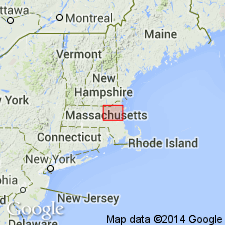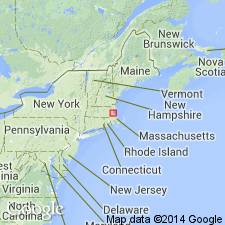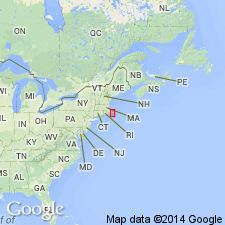
- Usage in publication:
-
- Middlesex Fells Volcanic Complex*
- Modifications:
-
- Named
- Dominant lithology:
-
- Basalt
- Tuff
- AAPG geologic province:
-
- New England province
Summary:
Middlesex Fells Volcanic Complex named in the Boston basin of eastern MA. Unit described as dark gray to black mafic flow rocks, pyroclastic deposits, and tuffs, all metamorphosed to amphibolite facies. Contains minor quartzite and gneiss. Predominantly fine-grained with thinly laminated lentils, pillow structures, and ripple-bedding. 15,000 m thick. Conformably overlies Westboro Formation; intruded by Dedham Granodiorite. Unconformably underlies Greenleaf Mountain and Burlington Formations. Age is Precambrian(?).
Source: GNU records (USGS DDS-6; Reston GNULEX).

- Usage in publication:
-
- Middlesex Fells Volcanic Complex
- Modifications:
-
- Not used
- AAPG geologic province:
-
- New England province
Summary:
Not used on MA State bedrock geologic map. [No explanation given. Still good usage.]
Source: GNU records (USGS DDS-6; Reston GNULEX).

- Usage in publication:
-
- Middlesex Fells Volcanic Complex
- Modifications:
-
- Overview
- AAPG geologic province:
-
- New England province
Summary:
Middlesex Fells Volcanic Complex preceded the emplacement of the Dedham Granite and the Lynn Volcanics, while the Brighton Volcanics postdate them. Middlesex Fells is a bimodal sequence of felsic and mafic volcanic rocks that occurs as blocks and roof pendants within the Dedham Granite. Felsic rocks were originally assigned to the Lynn. Geochemical data suggests that the basalts of the Middlesex Fells are alkali to transitional basalts that formed in an extensional environment, probably continental-rift. Oldest volcanics yet recognized in the Boston area (dated 700 to 800 Ma?).
Source: GNU records (USGS DDS-6; Reston GNULEX).

- Usage in publication:
-
- Middlesex Fells Volcanic Complex
- Modifications:
-
- Not used
- AAPG geologic province:
-
- New England province
Summary:
Not used on State bedrock geologic map of Zen and others (1983). Similar to Hunting Hill Greenstone and Cherry Brook Formation in stratigraphic position. Bell and Alvord's (1976) Middlesex Fells unit encompassed rocks mapped by Nelson (1974) as Cherry Brook Formation and Claypit Hill Formation, as well as mafic rocks in upper part of Blackstone Group shown on State bedrock map as unnamed greenstone and amphibolite unit (which includes Hunting Hill and other rocks). Descriptions of Middlesex Fells in its type area by Bell and Alvord (1976) and of Hunting Hill by Quinn and others (1948) are similar; therefore, author believes they can be correlated. Rocks previously mapped as Middlesex Fells were included in unnamed unit of metamorphosed mafic to felsic flow, volcaniclastic, and hypabyssal intrusive rocks on MA State bedrock map. [Chapters A-J in U.S. Geological Survey Professional Paper 1366 are intended as explanations and (or) revisions to 1:250,000-scale MA State bedrock geologic map of Zen and others (1983).]
Source: GNU records (USGS DDS-6; Reston GNULEX).
For more information, please contact Nancy Stamm, Geologic Names Committee Secretary.
Asterisk (*) indicates published by U.S. Geological Survey authors.
"No current usage" (†) implies that a name has been abandoned or has fallen into disuse. Former usage and, if known, replacement name given in parentheses ( ).
Slash (/) indicates name conflicts with nomenclatural guidelines (CSN, 1933; ACSN, 1961, 1970; NACSN, 1983, 2005, 2021). May be explained within brackets ([ ]).

